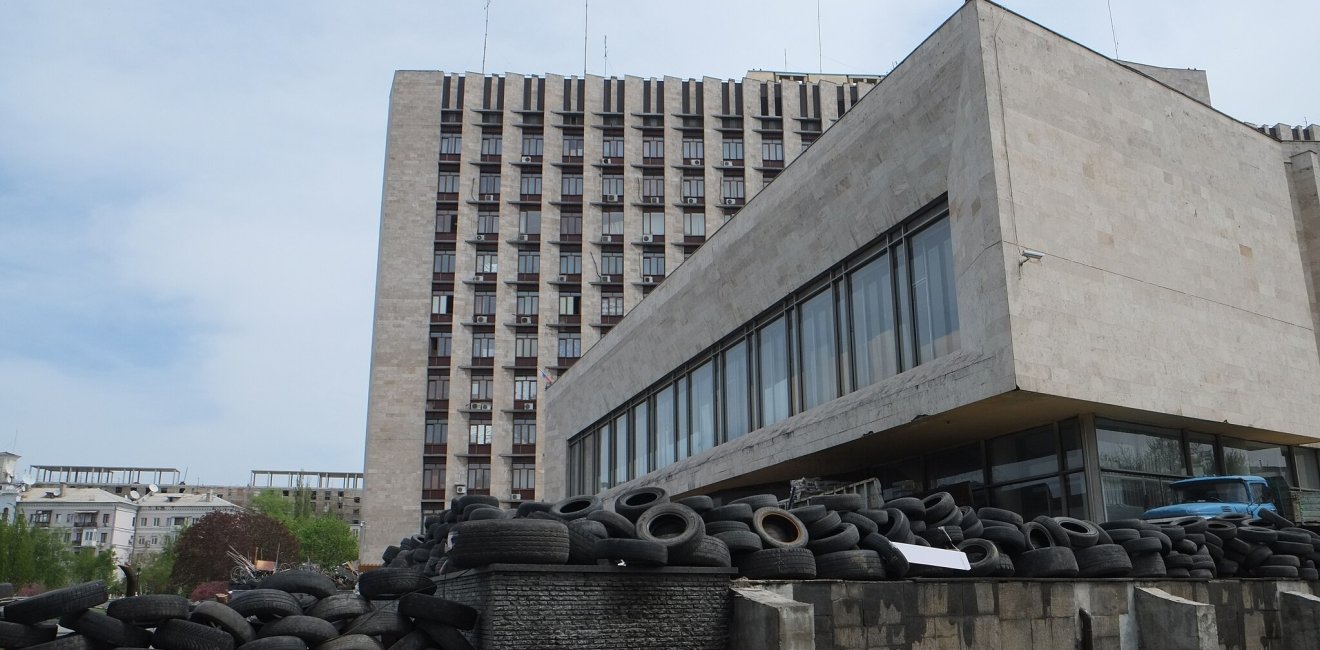
A blog of the Kennan Institute
“The play Titus Andronicus is considered the worst thing Shakespeare ever wrote. It’s so bad there’s doubt as to whether they even wrote it. There’s too much meaningless evil in the play, and almost no logic….But no….It’s not overdone at all. The play Titus Andronicus is being performed on the stages of Slovyansk, Kramatorsk, Donetsk, Horlivka, Luhansk… Hieronymus Bosch is doing the stage scenery.” Diarist Olena Stiazhkina wrote these words over the weekend of May 16–17, 2014, as she tried to make sense of what was transpiring all around her in eastern Ukraine.
A history professor in her hometown Donetsk, Stiazhkina published fiction on the side in her native Russian prior to the war, often using the pen name Olena Iurska. Looking back, she feels guilt at having enjoyed considerable success and garnered several prizes as a Russian author. All of this changed on March 2, 2014, when “little green men” dispatched from the Russian Federation linked up with pro-Russian forces in Donetsk and Luhansk to bring down Ukrainian rule.
The professional historian in Stiazhkina prompted her to start a diary, which begins on March 2 and ends on August 18, 2014, recording the chaos, horror, and inhumanity unfolding around her. Her wartime journal became available in June in English translation as Ukraine, War, Love: A Donetsk Diary through the Harvard Library of Ukrainian Literature.
Russian President Vladimir Putin understood that an invasion without an invasion—dispatching troops who were not wearing clear identification in 2014—allowed politicians in the West to look the other way. Even more cynically, they looked away even after so-called separatist forces brought down a civilian Malaysian Airways flight on its way from Amsterdam to Kuala Lumpur a few months later. She and her compatriots understood that a war had begun with Russia.
Prior to 2014, Stiazhkina wasn’t clear precisely who she was. Like many of us, she claimed many identities: historian, writer, mother, university professor, grateful reader, friend, wife, daughter. The order among these distinctions didn’t really matter; context did. After March 2014, one identity, she wrote, was “permanently in first place now. I’m a Ukrainian.”
On May 11, she set out a sarcastic methodological handbook for new invaders. “You can print out ballots on any printer. No need to be delicate here. You can have a lot of ballots. Or not. The quantity’s not important. Later, you’ll count them as instructed anyway. If you need more, add some. If you’ve got too many, toss some… Don’t use numbers over one hundred. Be aware that certain people don’t believe that something can win a hundred and fifteen percent of the votes. Well, right now they don’t. But we’ll fix that.”
Titus Andronicus-level horror runs throughout her diary as it does through Shakespeare’s ultimate revenge play, with too many examples to record here. Perhaps one scene will suffice: “We are polite people,” she observes. “Other ‘polite people’—with strong accents from the Caucasus—killed three men. First, they tortured them. They opened their bellies. The victims were still alive….And they were still alive when they were thrown into the river….That’s Slovyansk. That’s the ‘Russian world.’”
As a historian, she ponders what the conflict will mean when historians of a future era look back. “Later we will give this war a name,” she decides. “Our day of victory will be this war’s end. But this war’s beginning was in March 2014.”
She stops recording events in August 2014 as she begins a new life in Kyiv and at universities around Europe and the United States. She does so by observing, “All war diaries are histories of suffering. Anne Frank, Tanya Savicheva….‘Everyone is dead…’. But you know something? All my people are alive. Lotya and Surikova, and the photographer, and Granny Shura, and even Astro the poodle. We’re alive. Heroes don’t die.” And neither does Ukraine.
The opinions expressed in this article are those solely of the author and do not reflect the views of the Kennan Institute.
Author

Former Wilson Center Vice President for Programs (2014-2017); Director of the Comparative Urban Studies Program/Urban Sustainability Laboratory (1992-2017); Director of the Kennan Institute for Advanced Russian Studies (1989-2012) and Director of the Program on Global Sustainability and Resilience (2012-2014)

Kennan Institute
The Kennan Institute is the premier US center for advanced research on Eurasia and the oldest and largest regional program at the Woodrow Wilson International Center for Scholars. The Kennan Institute is committed to improving American understanding of Russia, Ukraine, Central Asia, the South Caucasus, and the surrounding region through research and exchange. Read more

Explore More in Focus Ukraine
Browse Focus Ukraine
Talking to the Dead to Heal the Living

Ukrainian Issue in Polish Elections


